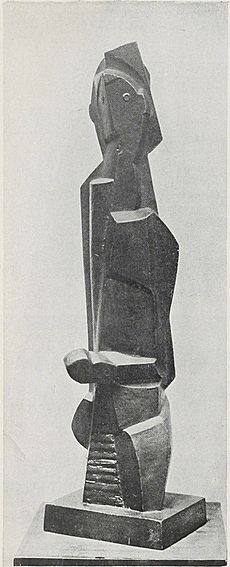Henri Laurens facts for kids
Henri Laurens (born February 18, 1885 – died May 5, 1954) was a famous French artist. He was known for creating amazing sculptures and illustrations.
Contents
Early Life and Art Beginnings
Henri Laurens was born in Paris, France. Before he became a well-known sculptor, he worked with stone. In 1899, he started taking drawing classes. His early art was much inspired by the famous sculptor Auguste Rodin.
Becoming a Cubist Artist
Later, Laurens became part of a new art movement in Montparnasse, a famous artistic area in Paris. From 1915, he began to create Cubist sculptures. This happened after he met other important artists like Pablo Picasso, Georges Braque, Juan Gris, and Fernand Léger.
Cubism was a new way of looking at art. Artists would break down objects into geometric shapes. Then they would put them back together in different ways. This showed the object from many angles at once.
Henri Laurens did not have to join the army during the First World War. This was because he had a leg amputated in 1909 due to a bone infection.
Artistic Achievements
Laurens was very talented in many areas. He used poster paint and created collages. He was also an engraver, which means he made prints. He even designed sets and decorations for the theater. In 1915, he illustrated a book for his friend, the writer Pierre Reverdy.
In 1937, he won the Helena Rubinstein Prize. This award helped him get more art jobs. In 1938, his art was shown in an exhibition with Braque and Picasso. This show traveled to big cities in Scandinavia.
In 1947, he made prints for book illustrations. In 1948, his art was displayed at the important international Venice Biennale. This is a huge art exhibition held in Venice, Italy. In the same year, he also had an exhibition in Basel, Switzerland.
Many of Laurens' sculptures were very large. A great example is his huge sculpture called L'Amphion. He first designed a smaller version. Then, in 1952, he created the final, massive sculpture. It was made for the Central University of Venezuela in Caracas. The architect Carlos Raúl Villanueva had asked him to create it.
Laurens' sculptures also influenced other artists. For example, his tomb design for an aviator in Paris influenced the architect Jørn Utzon. Utzon is famous for designing the Sydney Opera House.
Later Life and Legacy
Henri Laurens passed away in Paris on May 5, 1954. He collapsed while taking an evening walk. He was buried in the Cimetière du Montparnasse in Paris. His tomb is decorated with one of his own sculptures, called La Douleur (which means Grief).
See also
 In Spanish: Henri Laurens para niños
In Spanish: Henri Laurens para niños




